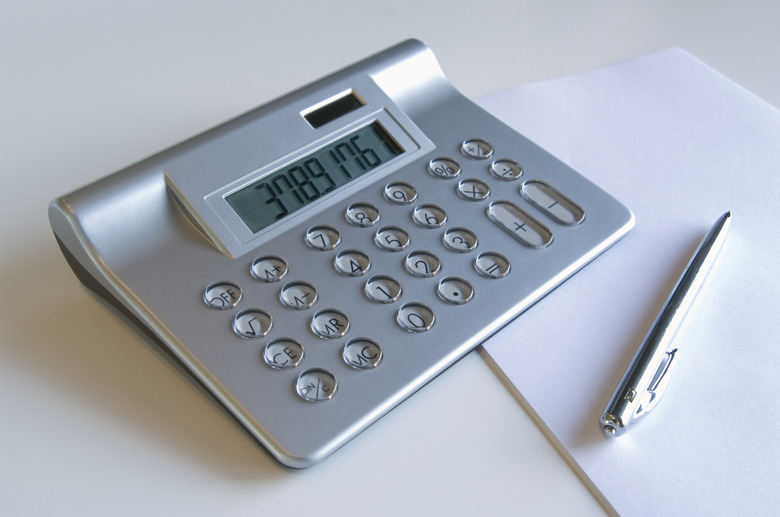How To Calculate Resistance For LED
LEDs, formerly known as Light Emitting Diodes, are those tiny green, yellow and white lights seen on electronic devices. These lights are used to indicate many things. Most often they are used to inform you that power is applied to your device.
If you want to include an LED in your electronic design, you will also have to include a resistor. An LED will quickly break, that is not light any more, if you don't. You will also have to select the right value of resistor to use. Low-current LEDs will require a higher resistor value than high-current LEDs.
Step 1
Determine the component arrangement of your LED design and the voltage level of the power supply used. For this example, use an LED connected in series with a resistor, referred to as a series LED resistor circuit. Assume that this series combination is connected across a 12 volt battery supply. Note that the circuit is connected as follows: the positive supply of the power supply is connected to the left end of the resistor, the right end of the resistor is connected to the anode of the LED and the cathode of the LED is connected to the negative terminal of the power supply.
Consider that different circuit arrangements will require different calculations for the resistance than the one illustrated below.
Step 2
Determine or estimate the forward voltage of the LED. Remember that the forward voltage is the minimum voltage required across the LED for it to emit light. Ask the manufacturer, an electronics parts store salesman or look on the LED data sheet to find out the forward voltage. You can also estimate the forward voltage. Most small LEDs have a forward voltage in the range of 1.5 to 3 volts. Consider using 2 Volts for an estimate if you can't find the exact value. Remember that in general the smaller LEDs will have a lower forward voltage.
Step 3
Determine or estimate the LED maximum current rating. Ask the manufacturer, an electronics parts store salesman or look on the LED data sheet for this value. You can also estimate the on current. Most small LEDs have maximum on-current rating within the range of 10 milliamperes to 30 milliamperes. Consider for the most part that the bigger the LED is, the more current it will be able to carry without being damaged. Consider an estimate of 20 milliamperes for the maxumum on current if you can't find the exact number. Remember that if the maximum current rating is exceeded in a working circuit there is the possibility that your LED will be damaged.
Step 4
Calculate the voltage across the resistor for the series LED-resistor circuit. Subtract the LED's forward voltage rating from the supply voltage used to power the circuit. For this example, with a supply voltage of 12 Volts and a LED forward voltage rating of 2 Volts, the voltage across the resistor will be 10 Volts, since 12 minus 2 is 10.
Step 5
Calculate the value of the resistor needed for the series LED resistor circuit. Divide the voltage across the resistor, obtained in the previous step, by the LED's maximum on current, obtained in step 3. For this example, the voltage across the resistor is 10 Volts and the maximum on current is 20 milliamperes. The resistance value is then 500 Ohms, since 10 divided 0.02 is 500. Remember to convert milliamperes to amperes for the calculation. Since there are 1000 milliamperes per ampere, 20 milliamperes is equivalent to 0.02 amperes.
Things Needed
- Pencil
- Paper
- Calculator
TL;DR (Too Long; Didn't Read)
If your calculations use estimated forward voltage and on current values, you may run into problems when you hook up your circuit. Consider that if you use too high of a value of resistor, your LED might not light or appear very dim. On the other hand, if you use too low of a resistor value, your LED may overheat and break. In this case, your LED may at first work, but after a few minutes you will notice that it no longer emits light.
Often it takes experience with LEDs to get the right resistor value. And that's because manufacturers often don't guarantee the forward value as an absolute number, but just as a minimum or maximum.
Cite This Article
MLA
Stansberry, Mark. "How To Calculate Resistance For LED" sciencing.com, https://www.sciencing.com/calculate-resistance-led-6326702/. 24 April 2017.
APA
Stansberry, Mark. (2017, April 24). How To Calculate Resistance For LED. sciencing.com. Retrieved from https://www.sciencing.com/calculate-resistance-led-6326702/
Chicago
Stansberry, Mark. How To Calculate Resistance For LED last modified March 24, 2022. https://www.sciencing.com/calculate-resistance-led-6326702/
